Author Archive
Posted on: July 6th, 2015 by Waterloo Region Crime Prevention Council
Film and Forum Evening with Howard Sapers
Thursday, September 10, 2015 ~ 6:30 pm – 9:00 pm Kitchener Public Library, 85 Queen St. N., Kitchener
Over the past 5 years, Canadians have witnessed dramatic changes to the criminal justice system during an era of declining crime rates. The “Safe Streets Act” (Bill C-10) and subsequent legislation ushered in sweeping tough on crime measures. Across Canada, profound financial, social and health impacts are expected. Do we understand what this shift in policy means?
Join us for an evening with one of Canada’s most respected correctional experts, Howard Sapers, Correctional Investigator for Canada. The evening also includes a special screening of the Canadian film “State of Incarceration” followed by a community discussion.
This is a rare opportunity to hear from one of Canada’s foremost experts on corrections, policy and criminal justice in Canada.
6:30pm – Welcome & Introductions
6:45pm – Film: “State of Incarceration”
7:30pm – Keynote: Howard Sapers
8:00pm – Community Discussion
Film – State of Incarceration (CBC, 2014) Canada’s crime rate is at its lowest point in more than forty years. So why are we spending hundreds of millions of dollars to get tough on crime now? More prisons cells, tougher laws for parole, more mandatory minimum sentences are all now part of Canada’s high-cost justice system – and they are all ideas that failed in the United States. Our criminal justice system is currently undergoing a radical rethink. This documentary looks at where our criminal justice system is headed.
Free event. Register through the Kitchener Public Library.
Posted on: April 7th, 2015 by Waterloo Region Crime Prevention Council
Back in February 2015, the Church Council on Justice and Corrections (CCJC), released a very promising evaluation report on the Circles of Support and Accountability (CoSA) program that operates across Canada. CoSA is a “community-based reintegration program, grounded in restorative justice principles, that holds sex offenders accountable for the harm they have caused while assisting with their task of re-entry into communities at the end of their sentences”.
The evaluation, the first of its kind in Canada, gives an in depth description of how the program works, documenting it’s success rate and cost savings due to reduced recidivism and reoffending. In short, the evaluation says that this program works.
Great news!
But then, on March 2nd 2015, it was announced that as of March 31, 2015, Correctional Services Canada (CSC) would not renew the funding it has been providing since 1996, as a partner to CoSA. The program has additional partners in numerous Canadian cities such as the Mennonite Central Committee Ontario (MCCO) for the program operated in Kitchener, Hamilton and Toronto. MCCO has funding from CSC until March 31, 2018.
CoSA Canada quickly released a statement to clarify and restate the real impacts of this program: a proven model that addresses a high risk crime against vulnerable people in a humane and accountable way and shows that it can reduce recidivism of the highest risk sexual offenders by 70 – 83%.
This is what we at the Crime Prevention Council would be inclined to call a “smart on crime” approach to reducing crime and victimization:
- the program is based in good evidence,
- the approach is measured and documented in similar ways across programs,
- it has produced excellent results,
- it is proven to reduce and prevent further crimes at a lower cost than keeping an individual incarcerated for “life”, and,
- helps to reintegrate individuals into our community, which is where 95% of people exiting prison, including those convicted of sexual offenses, will return eventually at the end of their sentences
Meanwhile, this ‘made in Canada’ approach has been successfully exported to a number of jurisdictions in the U.S. and the U.K., in addition to France, The Netherlands, Italy, Australia, New Zealand, Latvia and South Korea.
When programs show that they accomplish what they set out to do at comparatively low investment and provide a high return on investment to the safety of our community, their sustainability is not only vital, but smart and it makes so much more sense to support of them rather than cut them.
As such, the decision by CSC to cut funding for CoSA is tough to understand and needs further dialogue and consideration.
Posted on: February 3rd, 2015 by Waterloo Region Crime Prevention Council
Maybe even much like February 3rd, 2015… cold, crisp and clear, with a bright full moon.
A group of enthusiastic and passionate community leaders presented the work of the Community Safety and Crime Prevention Council to Waterloo Region Council. At the time, they had been operating for almost 2 years! Their proposal on February 3rd, 1995 was to evolve from a ‘task group’ to a more formal entity, with a paid staff!
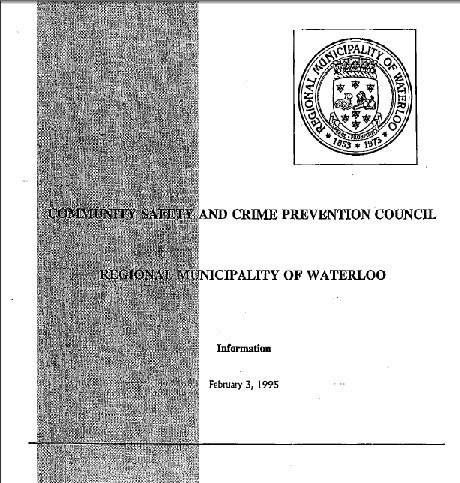

Looking back can be informative… and sometimes cringe worthy! In 20 years, our language and conceptions about crime and crime prevention have evolved so much!


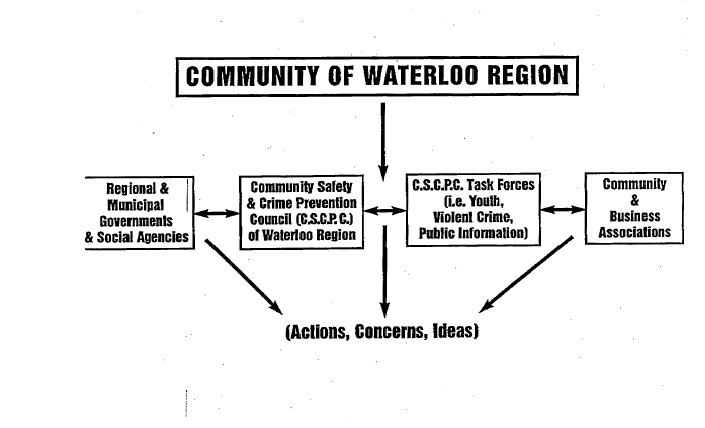
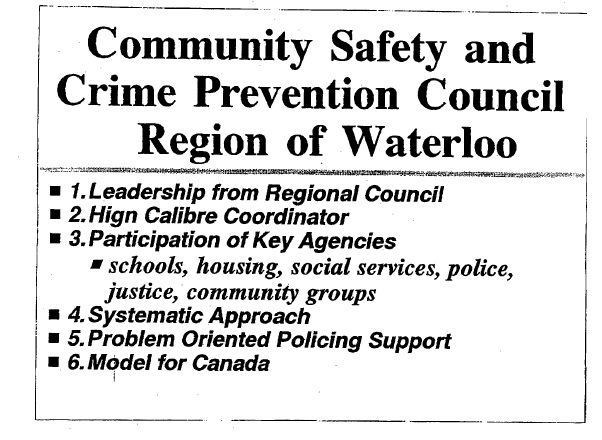
Did you catch point number two?? High calibre coordinator! That’s our very own Christiane Sadeler. She’s still the Executive Director to this day.
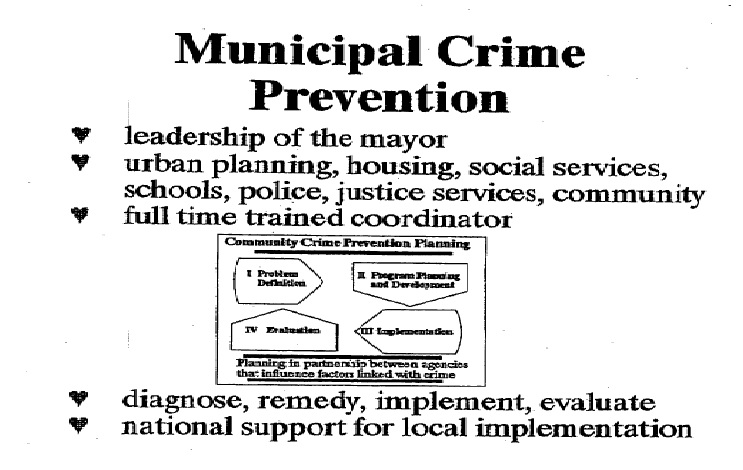
Love the heart bullet points!
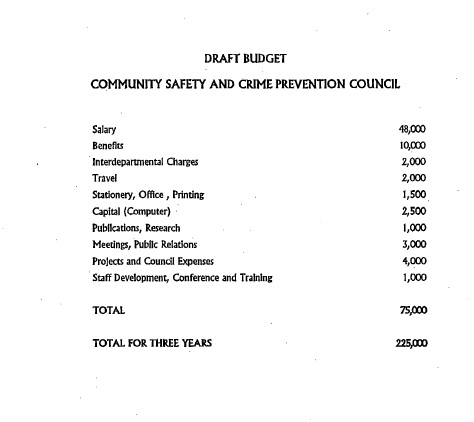
Well, there you have it folks, the presentation that launched a crime prevention through social development initiative in Waterloo Region, to the tune of $225,000 over 3 years. Such incredible growth and change over 20 years. If we had a spare $225,000 now…. well, we could do a lot of things. But one thing we would do is hire a really brilliant evaluator to capture and measure the trajectory of community change over the course of 20 years as a result of this thing we now know as the Waterloo Region Crime Prevention Council.
Can you imagine the things we would learn?
Has the WRCPC made a lasting impression on our community? What is that to you or your organization?
Posted on: December 30th, 2014 by Waterloo Region Crime Prevention Council
We’ve been in reflection mode this week at the WRCPC office. The time of year lends itself perfectly to this kind of ‘look back’ at the year that was 2014. I hope you are enjoying your own reflections. And, since we’re at it, why don’t we do some reflecting together, with the help of Smart on Crime.
We had such a variety of blog posts this year, ranging from what we were reading to crime stats, to special posts from Friends of Crime Prevention. Early in 2014, we wrapped up a year long examination of the root causes of crime. With the end of inREACH in Waterloo Region, we took some time to share what our community has learned from inREACH and engage our community in a follow up event in April where planned next steps. We even introduced you to some new words to enrich your vocabulary! And of course, we couldn’t help but challenge our community with some harder hitting posts.
Our readers are as diverse as our blog posts, which would explain the diversity of popular blogs this year. Here’s the round up of our top 14 posts from 2014.
- Public Opinion & Crime – Anthony Piscitelli
“Since 2006 the Canadian government has focused on being tough on crime. The policy approach continues to this day but it seems the Canadian public is starting to see these changes as a policy excess. Instead of focusing on punishment, public opinion polls suggest the government focus should be on prevention through education and social development programs.”
- Trent’s Trajectory: The dollars and $ense of crime prevention

- A new story is needed – guest post by Friend of Crime Prevention, Doug McKlusky
“As a Friend of Crime Prevention, I believe that that the heart of crime prevention is through social and community development…..
Imagine neighbourhoods where everyone feels a sense of belonging, where inclusion trumps fear.
Imagine workplaces where people belong, and where respect and collaboration trump power and politics.
Imagine schools where belonging trumps bullying and streaming.”
- The new story continues…. – guest post by Friend of Crime Prevention, Doug McKlusky
“I do believe that many small actions will add up to a large action on the road to building a community of belonging. It can be as simple as acknowledging the presence of a homeless person in downtown Kitchener, they are part of our community, a friendly smile goes a long way in making a person feel like they belong. I challenge you to do something to make our community a community of belonging, smile at a stranger, volunteer somewhere in your community, it will make a difference, it will connect you!”
- Inspired by inREACH: Reflections of a youth outreach worker – Youth Outreach Worker, Krista McCann
“inREACH fostered a working environment that not only allowed us, but encouraged us to work outside of the box. I’d be lying to say the task was not daunting at first. In my previous experience working as a Youth Worker I had never been given such flexibility and confidence within a position to achieve the desired outcome; an outcome that was not based on the amount of programs ran or number of program participants but the ability to engage youth in their community.”
- Neighbourhood policing: A learning opportunity for Friends of Crime Prevention – WRCPC Student, Ryan Maharaj
“To usher in 2014, WRCPC hosted a learning event on ‘Neighbourhood Policing’. Naturally, Friends of Crime Prevention & WRCPC have a common interest with the police on all things related to crime prevention, community safety and well-being. Inspector Kevin Thaler from the Waterloo Regional Police Service was our guest to unveil the recent sweeping changes to their organizational structure, daily operations and dispatch methods. The results are what is now known as Neighbourhood Policing.”
- Between life and death: Responding to drug overdoses in Canada – former WRCPC student, Kayla Follet
This article appeared in the July 14, 2014 edition of the Waterloo Region Record.
- By the numbers: Wading through police-reported crime statistics 2013 – Anthony Piscitelli
“Statistics Canada released their annual Police-reported crime statistics 2013 report in July (and in French). There is always so much to sift through and interpret. Learn more from the Canadian Criminal Justice Association.”
- By the numbers: Hate crimes in Waterloo Region – Anthony Piscitelli
“In 2009, the Kitchener-Cambridge-Waterloo census metropolitan area (CMA) had the highest hate crime rate in Canada, according to police reported statistics. Did you catch the end of that sentence? “…..according to police reported statistics”. It might seem insignificant, but it might be the key to understanding why the 2009 hate crime rate in Waterloo Region is so high compared to other CMAs in Canada. “
- No clichés: A reflection on working with the youth of inREACH – guest post by Karl Garner
“Having been with inREACH, it became quite evident, that the youth we worked with often experienced clichés in their lives. They were labeled, stereotyped, and their behaviours were often predicted by the adult world around them, yet most of the time no one knew anything about them. Outside of where they lived, or who they hung out with, or the school they went to, or perhaps what they look like, do many even know these youth? The label which is the umbrella they live under is their cliché.”
- Ignoring what we’ve learned. Or, how to ensure street gangs become a real problem in Waterloo Region – Ryan Maharaj
“It’s easy to assume that we should apply what we’ve learned from the inREACH project to better support marginalized youth in our community. But have you every stopped to wonder, what happens if we ignore what we’ve learned? What if we shed the rose-coloured glasses and donned the shades of pessimism to see the barriers that stand in our way? What if we tried to see the glass half empty? How can we make a problem like street gangs in Waterloo Region, worse?”
- The community weighs in on the root causes of crime: change and action – Dianne Heise
“How do we get at the root causes of crime and prevent it from happening in the first place?
This isn’t a direct, straight answer, but, the Waterloo Region Crime Prevention Council believes part of the solution is to monitor the root causes of crime over time. Then we, as a community, can better understand and address the social, community and economic conditions associated with crime and victimization. Check out the Waterloo Region Crime Prevention Council’s report – A Snapshot in Time: The Root Causes of Crime in Waterloo Region to find out how we are doing in early childhood development, employment, community trust and other important indicators.”
….. and part 2 of The community weighs in on the root causes of crime: change and action
- Why communities need neighbourhood-based programming for youth – guest post by Courtney Didier, Alison Neighbourhood Community Centre
“We have worked with youth who have great dreams and aspirations for the future, but have trouble putting their vision into a workable plan. On the other side of the coin, we have worked with youth who have little to no confidence in their abilities, thus requiring a little more encouragement and a little more trial and error in determining what really gets them motivated and excited.”
- Lessons learned in a gang project – Dianne Heise and Rohan Thompson
“Gang Prevention Is…. a) addressing underlying issues, and, b) not about getting a kid to take off the bandana. We often heard – “we’ve got this kid, he’s in a gang – fix him.” So often in our case management and system navigation work, it wasn’t about getting this young person to take off his bandana or to stop hustling or whatever, we never approached the work in that fashion. But it was about the underlying issues and working on them. Mostly we were dealing with issues of poverty, untreated trauma, family breakdown, substance abuse, disengagement and lack of opportunities. These are the problems that young people and gang members and people in general are dealing with. We want to demystify that label of gang member that says their needs are different than any other groups. These same issues are the drivers behind the behaviours.”
So many great reads from 2014. But if you’re in the mood for something to watch, rather than read, might I suggest our newest video on Collaboration!
We look forward to bringing more great Smart on Crime blogs for you in 2015. Better yet, we love hearing your comments, reactions and responses to the posts and guest commentaries. We look forward to hearing more from you next year!
Posted on: August 29th, 2014 by Waterloo Region Crime Prevention Council
In 2009, the Kitchener-Cambridge-Waterloo census metropolitan area (CMA) had the highest hate crime rate in Canada, according to police reported statistics. Did you catch the end of that sentence? “…..according to police reported statistics”. It might seem insignificant, but it might be the key to understanding why the 2009 hate crime rate in Waterloo Region is so high compared to other CMAs in Canada.
A criminal offence against a person or property is considered a hate crime when there is evidence that the offence was motivated by hate, based on the victim’s: race, ethnic origin, language, colour, religion, sex, age, mental or physical disability, sexual orientation, or other similar factors. In 2009, in Waterloo Region, Police identified 93 crimes that fit this definition. While the number doesn’t tell us the nature of these reported hate crimes, these 93 situations represent the number of crimes that came to the attention of police that were classified as hate crimes in 2009.
But before we jump to conclusions about Waterloo Region being a hot bed of hate and discrimination, we might want to take a look at other cities and regions. St. John’s, Saint John, Barrie and Thunder Bay reported zero hate crimes incidents in 2009 and Saguenay, Trois-Rivieres and Greater Sudbury reported one hate crime incident each. When it comes to any urban centre, we can be reasonably confident that zero or one hate crime per year might have more to say about what comes to the attention of police and how it is classified than reality.
What we might conclude from the Census Metropolitan report in 2009 is that the reporting approaches are at this time too diverse to portray an accurate cross city picture. Comparisons between jurisdictions require similar reporting standards and such consistency did not exist in 2009. Thus, higher numbers might point to a more rigorous reporting and/or greater community attention to an issue.
By just looking at the numbers alone, Kitchener-Waterloo was put on one of eight worst places in Canada to move to for immigrants. This use of data without context was easy to share as a quick sound bite, but provided a woefully inaccurate picture of the community.
But the report is not fully useless by any stretch of the imagination. What we can and should do is use the data to compare hate crime rates over time. Such comparison works on the assumption that Waterloo Regional Police Service are more or less consistent in how they define and report hate crimes from year to year. On that basis Waterloo Region saw a steady decline in hate crimes from 93 in 2009, to 55 in 2010, to 41 in 2011 and 30 in 2012. That is a promising emerging trend. There is a BUT…
One hate crime is simply one hate crime too many. Crime prevention and the creation of a peaceful (read “inclusive”) society are intimately linked. And there can be no peace without inclusion. Understanding the nature of hate crimes in Waterloo Region should be a critical next step in our shared goal of creating a community that is safe for everyone. Armed with information about who the victims of hate crimes are, who has committed the offences, and what trends we observe overall provides us with data that can help us to begin to prevent these crimes.
 In 2012, the KW Multicultural Centre, along with numerous community partners developed a series of workshops designed to help community members better understand hate crimes, learn how to recognize potential hate crimes, how to help victims and what to do in the event of witnessing an incident that might be a hate crime. The workshop materials were designed in a way that those who completed it could deliver the workshop to other groups. To date, more than 15 workshops have been conducted in our community with over 250 people taking the training. These and other efforts help to raise awareness about the importance of hate crime prevention.
In 2012, the KW Multicultural Centre, along with numerous community partners developed a series of workshops designed to help community members better understand hate crimes, learn how to recognize potential hate crimes, how to help victims and what to do in the event of witnessing an incident that might be a hate crime. The workshop materials were designed in a way that those who completed it could deliver the workshop to other groups. To date, more than 15 workshops have been conducted in our community with over 250 people taking the training. These and other efforts help to raise awareness about the importance of hate crime prevention.
In an effort to do our part and continue the dialogue and problem solving, the Waterloo Region Crime Prevention Council recently released a RAP Sheet on Hate Crimes. The RAP sheet contains a number of suggestions on “what you can do” to address and prevent hate crimes. We are also committed to continuing to watch the data and educate ourselves by speaking to those who have lived experiences. Watch this page and our website for information we gather and for what we are learning. Also watch for how you can stay or get involved.
Meanwhile, we are keen to learn what you think! We are especially keen to learn what ideas you have to prevent hate crime before it happens.
Author: Anthony Piscitelli is Supervisor, Planning & Research with the Waterloo Region Crime Prevention Council. He collaborates on all research efforts published by WRCPC.
Posted on: August 12th, 2014 by Waterloo Region Crime Prevention Council
Statistics Canada released their annual Police-reported crime statistics 2013 report in July (and in French). There is always so much to sift through and interpret. But here’s a beginning summary of the highlights from the Canadian Criminal Justice Association.
The police-reported Crime Severity Index (CSI), which measures the volume and severity of crime, declined 9% in 2013 compared with 2012. This was the 10th consecutive decline in the index. The CSI was 36% lower than 10 years earlier.
The traditional crime rate also declined in 2013 compared with 2012, falling 8%. It continued its long-term downward trend that began in the early 1990s, reaching its lowest level since 1969. Since 1962, the traditional crime rate has measured the volume of crime, but does not take into account the severity of crimes.
Canadian police services reported just over 1.8 million criminal incidents (Criminal Code offences excluding traffic) in 2013, down approximately 132,000 from the previous year.
Most offences were down in 2013. The decline in the CSI was specifically attributable to declines in breaking and entering and robbery. Decreases in some of the less serious but very frequent offences, such as theft of $5,000 or under and mischief, also contributed to the drop in the CSI.
However, some offences were up in 2013. In particular, police services reported more incidents of extortion, child pornography, aggravated sexual assault (level 3), sexual violations against children and identity fraud.
Crime Severity Index down in most provinces and territories
In 2013, most provinces and territories recorded a decrease in their CSI compared with 2012. However, the CSI increased in Yukon (+6%) and Newfoundland and Labrador (+1%).
Prince Edward Island, New Brunswick, Quebec and Manitoba (-12% each) recorded the largest declines among the provinces and territories.
In most provinces, the decline in the CSI was largely due to fewer breaking and entering incidents. However, in British Columbia, robberies were behind the decline in the CSI. In the Northwest Territories, a decrease in homicides resulted in the drop in the CSI, whereas the decline in Nunavut was due to a large decrease in incidents of mischief.
As in previous years, each territory had a higher CSI than any province. Saskatchewan had the highest CSI among the provinces, while Ontario had the lowest.
Crime Severity Index down in almost all census metropolitan areas
For the first time since 1998, the first year for which the CSI was calculated, none of Canada’s census metropolitan areas (CMAs) recorded an increase in its CSI. The CSI was unchanged in Edmonton, while it declined in all other CMAs. The largest decrease compared with 2012 was in Victoria (-17%).
Despite a 7% drop in its CSI, Regina had the highest CSI of any CMA, while Barrie and Guelph had the lowest.
Violent Crime Severity Index continues to decline
The violent CSI fell 10% in 2013 compared with 2012, marking the seventh consecutive decrease.
Canadian police services reported approximately 384,000 violent incidents in 2013, down about 32,000 from the previous year. The decline in the violent CSI was mainly due to a decrease in robberies and, to a lesser extent, fewer assaults with a weapon or causing bodily harm (level 2), common assaults (level 1) and uttering threats.
Police reported 505 homicides in 2013, down 38 from 2012. The homicide rate was 1.44 victims per 100,000 population, the lowest rate since 1966. Police also reported 642 attempted murders in 2013, down 23 from the previous year.
Every province and territory except Newfoundland and Labrador saw a decrease in their violent CSI compared with 2012. Similarly, every CMA saw their violent CSI decline except Trois-Rivières, St. John’s, Brantford and Calgary, which recorded increases.
Increase in police-reported “sexual violations against children”
In 2013, the police reported 4,232 incidents in the “sexual violations against children” category, 279 more than in 2012. This was one of the only violent crime categories to increase in 2013.
The “sexual violations against children” category includes five specific offences under the Criminal Code: luring a child via a computer, sexual exploitation, sexual interference, invitation to sexual touching and making sexually explicit material available to a child. However, this category excludes sexual assaults against children, which are classified with all other sexual assaults, including those against adults.
Of the sexual violations against children, luring a child via a computer showed the greatest increase, rising 30% in 2013, followed by sexual exploitation (+11%). In contrast, invitation to sexual touching decreased 5%.
Non-violent Crime Severity Index is down
Most crimes reported by the police are non-violent. Police reported just over 1.4 million non-violent incidents in 2013, or nearly four crimes in five, of which 1.1 million were property crimes. The non-violent CSI decreased 8% compared with 2012, the 10th consecutive decrease in this index. The non-violent CSI was 40% lower than a decade earlier.
While most non-violent offences declined in 2013, the decrease in the non-violent CSI was mainly due to a large drop in the number of incidents of breaking and entering, theft of $5,000 or under and mischief. However, some offences in the non-violent category rose in 2013, specifically counterfeiting, child pornography and identity fraud.
Almost every province and territory saw their non-violent CSI decline in 2013. The largest decreases were in New Brunswick and Prince Edward Island, while the non-violent CSI was stable in Newfoundland and Labrador and increased in Yukon.
Most CMAs also saw a decrease in their non-violent CSI except Edmonton, where the index rose in 2013 as a result of more motor vehicle thefts and theft of $5,000 or under.
Youth Crime Severity Index down for the fourth consecutive year
The youth CSI fell by 16% in 2013 compared with 2012, the fourth consecutive decline. The youth CSI measures the volume and severity of crimes for which an accused aged 12 to 17 was identified.
The decline in the youth CSI was mainly due to fewer youths accused of robbery, breaking and entering or theft of $5,000 or under.
Every province and territory except Yukon saw their youth CSI decline compared with 2012. Among the provinces, Saskatchewan recorded the highest youth CSI, while British Columbia, Ontario and Quebec had the lowest.
With the release of the Statistics Canada report also comes analysis and critique of the statistics. Here’s a few that we read:
Did you see anything that surprised you in the Statistics Canada report? Encouraged you? Alarmed you?
Posted on: April 7th, 2014 by Waterloo Region Crime Prevention Council
Before inREACH ended in December 2013, I shared 5 important lessons learned from the inREACH gang prevention project with the Waterloo Region Crime Prevention Council. While project funding has ended, some parts continue and there is much to be learned about addressing youth gang involvement in our community for the future. Here are some highlights.
1. What are your assumptions and values?
We need to ask ourselves this central question – what are the fundamental assumptions and beliefs we have about the young people we work with? Do we feel people are broken and need to be fixed? Or – do we believe people are full of capacities and if supported correctly, they can realize their potential? I’m not saying people don’t come with their problems, but the question is what are we focused on because that informs how you do the work. It took us a while to get this right. This idea was expressed well by a youth participant:
“It’s…for us, run by us and gonna involve all of us..What do you want to see in your community, and what are your personal talents or anything that is special to you that you want to show everybody else, and maybe those people might like it too right? So- opening new opportunities. It’s not just to keep kids off drugs but for under-privileged kids, kids who may have never had a chance to be part of something like you know…discover their love of art…so it’s giving everybody a chance to actually do…the things they want to do, so that’s why I started coming.”
This is powerful because it’s raising the bar. It’s not just getting youth out of the gang – but getting them into a job or back in school and even realizing some of their hopes and dreams. If you believe that people are full of possibilities – then the work is geared more to helping people realize that potential versus simply preventing them from doing something.
2. Gang Prevention Is:
- addressing underlying issues
- not about getting a kid to take off the bandana
We often heard – “we’ve got this kid, he’s in a gang – fix him.” So often in our case management and system navigation work, it wasn’t about getting this young person to take off his bandana or to stop hustling or whatever, we never approached the work in that fashion. But it was about the underlying issues and working on them. Mostly we were dealing with issues of poverty, untreated trauma, family breakdown, substance abuse, disengagement and lack of opportunities. These are the problems that young people and gang members and people in general are dealing with. We want to demystify that label of gang member that says their needs are different than any other groups. These same issues are the drivers behind the behaviours.
3. Gang prevention is:
- increasing engagement and inclusion
- working at individual and community levels
Young people demonstrated so clearly that they WILL engage. This matters because pro-social relationships and connections are essential for preventing youth from participating in gangs.
Unfortunately, adolescents and young adults are much less involved in community activities than other groups, particularly those experiencing marginalization due to where they live or challenges they face. Researcher Mark Totten says “there is an epidemic of social exclusion in Canada.” inREACH very successfully supported young people’s inclusion and engagement, in community centres, recreation, school, employment, services and more. This is a promising way to build assets and address risk factors in a holistic and non-stigmatizing way. However, it wasn’t just about engaging individual youth. The community was also mobilized and systems needed to make some changes in order to be more inclusive.
4. inReach is an example of an effective hub model
inReach is a comprehensive wraparound hub model demonstrating an effective way to support young people. It was comprehensive because all the right supports, services, staff and organizations were involved. It was a mobile hub which was key for meeting young people where they’re at – whether at the office, Tim Horton’s or their home. Dedicated multi-disciplinary teams brought diverse skills to the work and learned strategies and skills from each other. It was not done at a desk.
5. You Need The Right People On The Bus
You need to have the right people and organizations involved in the project and that was really key to the success of inREACH. People have to be there for the right reasons, share the same vision and be able to check their egos at the door. It can’t just be about what’s good for your own organization. Collaboration requires a thoughtful discussion before you bring people on the team. Everyone involved with inREACH was fully invested and went above and beyond because they were passionate and believed in it.
The community should be proud of all that it has accomplished.
Co-authors: Dianne Heise & Rohan Thompson – Dianne Heise is the Coordinator of Community Development and Research with the Waterloo Region Crime Prevention Council and worked with the inREACH project while she was a Master of Community Psychology student at Wilrid Laurier University. Dianne also worked on the final evaluation of the inREACH project with Dr. Mark Pancer (WLU).
Rohan Thompson was the Project Manager for the inREACH Street Gang Prevention Project (2010 – 2013). At the end of the project, Rohan returned to his role with the City of Kitchener.

Rohan Thompson (L) and Dianne Heise (R)
Posted on: March 27th, 2014 by Waterloo Region Crime Prevention Council
I agree with the sayings – ‘there’s always more to learn’ and ‘it’s never too late to learn.’
I lived this out when I returned to university for a Masters degree the same year my daughter started university. Luckily she wasn’t too embarrassed to be at school with her mom. My timing turned out to be perfect for another reason as well. During my time in school I had the amazing opportunity to be involved with the research and evaluation of the innovative and highly successful gang prevention project, inREACH. I can guarantee you; I learned something new every day.
An excellent summary of the evaluation report for inREACH highlights a LOT of really important learning and accomplishments as a result of this collective community effort over the past few years. Sharing our story: Lessons learned from the inREACH experience describes how the project was implemented, the young people it served in the treatment and prevention programs, and the many positive impacts of the project on young people, neighbourhoods, organizations and the community as a whole.
 The most important lessons and understandings learned from inREACH will inspire community action toward a future where all young people feel part of a caring community and have the opportunities and the supports they need and deserve. But, any evaluation isn’t even worth the paper it’s printed on if it just sits on a shelf. We need to apply the evaluation findings so that we can affirm what might already work but also make changes where needed.
The most important lessons and understandings learned from inREACH will inspire community action toward a future where all young people feel part of a caring community and have the opportunities and the supports they need and deserve. But, any evaluation isn’t even worth the paper it’s printed on if it just sits on a shelf. We need to apply the evaluation findings so that we can affirm what might already work but also make changes where needed.
Here are 3 key things we learned from the inREACH experience that could help us more effectively engage young people who are marginalized and better address their needs.
It Works!
 Some believe that teenagers – particularly those labelled as “trouble” – don’t want to be involved in community activities or mentoring relationships with adults. The evaluation busts that myth by demonstrating very clearly – that if organizations and communities take the right approach – then many adolescents and young adults, will participate in asset building activities like arts and sports. Many will also seek assistance for challenges they face with things like addictions, gang involvement or finding a job or a home, when they have developed a trusting relationship with an adult who meets them ‘where they’re at.’ The evaluation results also clearly demonstrated that when young people got involved in their communities and received help with life challenges, they experienced many positive benefits and changes. Over 95 % of youth agreed their involvement “helped them move in the direction in life they wanted to go.” For example, youth said:
Some believe that teenagers – particularly those labelled as “trouble” – don’t want to be involved in community activities or mentoring relationships with adults. The evaluation busts that myth by demonstrating very clearly – that if organizations and communities take the right approach – then many adolescents and young adults, will participate in asset building activities like arts and sports. Many will also seek assistance for challenges they face with things like addictions, gang involvement or finding a job or a home, when they have developed a trusting relationship with an adult who meets them ‘where they’re at.’ The evaluation results also clearly demonstrated that when young people got involved in their communities and received help with life challenges, they experienced many positive benefits and changes. Over 95 % of youth agreed their involvement “helped them move in the direction in life they wanted to go.” For example, youth said:
“they taught me to actually think before I acted…just keeping my cool overall and staying relaxed and not being so stressed out.”
“It helped me see the value of myself.”
Learning what it takes – with youth
 Sharing our Story describes key elements of the inREACH approach that was so successful. It took
Sharing our Story describes key elements of the inREACH approach that was so successful. It took
- the development of trusting relationships between staff and young people;
- listening to the youth and involving them in decision-making,
- recognizing youths’ strengths, skills, and interests, and
- making programs and services more accessible.
The evaluation report fleshes out some details of HOW to implement these approaches, which is the challenging part.
One illustration follows:
“I don’t think that they have ever had an adult say “what are your dreams?” and “how are you going to achieve those?” and then try to help them… That is my biggest question when I first meet a kid….it gets them thinking…. Then believing in them too and showing them you really care.” (Project staff)
Learning what it takes – the community’s role
inREACH was a collaborative venture of multiple organizations. The evaluation documents how these partnerships enabled organizations to work together more effectively, to work with youth in a different way, to access more services and resources and to “produce systemic change – changes in the way systems and organizations in the community approached the problem of gangs and at-risk youth.” (p 10)
Feedback to Community
It was important to report back to people who shared their thoughts and stories of involvement so I returned to many of the neighbourhood programs. Young people were keen to take the summary booklets and some were excited to see their own photographs featured there. Some youth who had been interviewed wanted the full 140 page version, partly to see if they were quoted there. There was a sense of pride for what they had created and accomplished and some commented on the huge difference the programs made in their lives.
 Continuing the Learning
Continuing the Learning
We know that if fewer adolescents and young adults experienced marginalization due to where they live or the challenges they face, then fewer young people would be attracted to gangs as a solution to their problems or to find a sense of belonging. So, it begs the question…. What should the community take forward from this youth gang prevention project?
There’s so much to talk about – outreach, social media, a youth engagement approach, new ways of collaborating across agencies, the role of neighbourhood community centres….
We look forward to working with our community to keep learning, but also move the learning to action. The upcoming event “Engaging marginalized youth” will help us do just that and you can join us on Friday April 11, 2014. Registration is required for the event and you can register here. [UPDATE: this event is now SOLD OUT. You can still register but you will be added to the wait list in case of cancelations.]
There’s always more to learn…
Photo Credits: all photos taken by inREACH youth during PhotoVoice projects. 2012
Posted on: March 25th, 2014 by Waterloo Region Crime Prevention Council

Trent’s Trajectory is fictional account of a sixteen year old teenager as he becomes an adult. The infographic, created by Wade Thompson, begins by discussing the risk and resiliency factors Trent faces. The story then branches into two paths. In the first path, Trent does not receive community supports and his risk factors drive the story culminating in a three year prison sentence. In the second path, Trent receives supports from the inREACH project. His resilience factors grow and Trent successfully transitions into adulthood.
Typical stories from the justice system and the inREACH program build Trent’s fictional story. Due to space constraints the ‘current path’ contains less minor crimes than would be expected from a repeat young offender and a few more serious ones. While this slightly changes the story, the overall justice system costs are realistic. It is important to note, while the story is specifically about the inREACH program similar outcomes can be reached for at risk youth in many other prevention programs.
Does this raise any questions for you? What do we do with this information now that inREACH has ended?
Posted on: March 19th, 2014 by Waterloo Region Crime Prevention Council

When a community project ends, such as inREACH, the street gang prevention project in Waterloo Region, it doesn’t really completely end. Sure, the office may be closed, the sign taken down, the telephones disconnected and the staff moved on to other jobs, but things have changed in the lives of youth, individuals and our community.
Even after a project ends, it is our responsibility to capture what worked well and what didn’t so we can continue to change ourselves, organizations, services, systems and ultimately our community to better engage & support marginalized youth in positive action and change.
It takes time to capture what’s been learned, how it applies, who continues the work and how we know it’s making a difference. That’s why we’re hosting:
“Engaging Marginalized Youth: Harnessing Experience from the inREACH Project”
Friday April 11, 2014
9am – 11am
Knox Presbyterian Church, 50 Erb Street West, Waterloo
Please Register if you plan to attend
To make the most of our time together that morning, we have prepared an advance blog series featuring 8 individuals who worked closely with inREACH; project staff, neighbourhoods, evaluators and community leaders. Their thoughts and reflections are sure to stimulate your ideas, – don’t hold back! – post comments and questions to the authors as the blogs are posted so we begin to think and talk about the issues now and can jump right in on April 11th.
Think of this blog series as the pre-game show, starting now.
At the event, it will be up to the community to determine and decide what actions we, the collective WE, can and must take to continue some of the work of engaging marginalized youth in our community.
Please comment, share, tweet, Facebook and reblog this series to help spread the word and share the learning.










 In 2012, the
In 2012, the
 The most important lessons and understandings learned from inREACH will inspire community action toward a future where all young people feel part of a caring community and have the opportunities and the supports they need and deserve. But, any evaluation isn’t even worth the paper it’s printed on if it just sits on a shelf. We need to apply the evaluation findings so that we can affirm what might already work but also make changes where needed.
The most important lessons and understandings learned from inREACH will inspire community action toward a future where all young people feel part of a caring community and have the opportunities and the supports they need and deserve. But, any evaluation isn’t even worth the paper it’s printed on if it just sits on a shelf. We need to apply the evaluation findings so that we can affirm what might already work but also make changes where needed. Some believe that teenagers – particularly those labelled as “trouble” – don’t want to be involved in community activities or mentoring relationships with adults. The evaluation busts that myth by demonstrating very clearly – that if organizations and communities take the right approach – then many adolescents and young adults, will participate in asset building activities like arts and sports. Many will also seek assistance for challenges they face with things like addictions, gang involvement or finding a job or a home, when they have developed a trusting relationship with an adult who meets them ‘where they’re at.’ The evaluation results also clearly demonstrated that when young people got involved in their communities and received help with life challenges, they experienced many positive benefits and changes. Over 95 % of youth agreed their involvement “helped them move in the direction in life they wanted to go.” For example, youth said:
Some believe that teenagers – particularly those labelled as “trouble” – don’t want to be involved in community activities or mentoring relationships with adults. The evaluation busts that myth by demonstrating very clearly – that if organizations and communities take the right approach – then many adolescents and young adults, will participate in asset building activities like arts and sports. Many will also seek assistance for challenges they face with things like addictions, gang involvement or finding a job or a home, when they have developed a trusting relationship with an adult who meets them ‘where they’re at.’ The evaluation results also clearly demonstrated that when young people got involved in their communities and received help with life challenges, they experienced many positive benefits and changes. Over 95 % of youth agreed their involvement “helped them move in the direction in life they wanted to go.” For example, youth said: Sharing our Story describes key elements of the inREACH approach that was so successful. It took
Sharing our Story describes key elements of the inREACH approach that was so successful. It took Continuing the Learning
Continuing the Learning